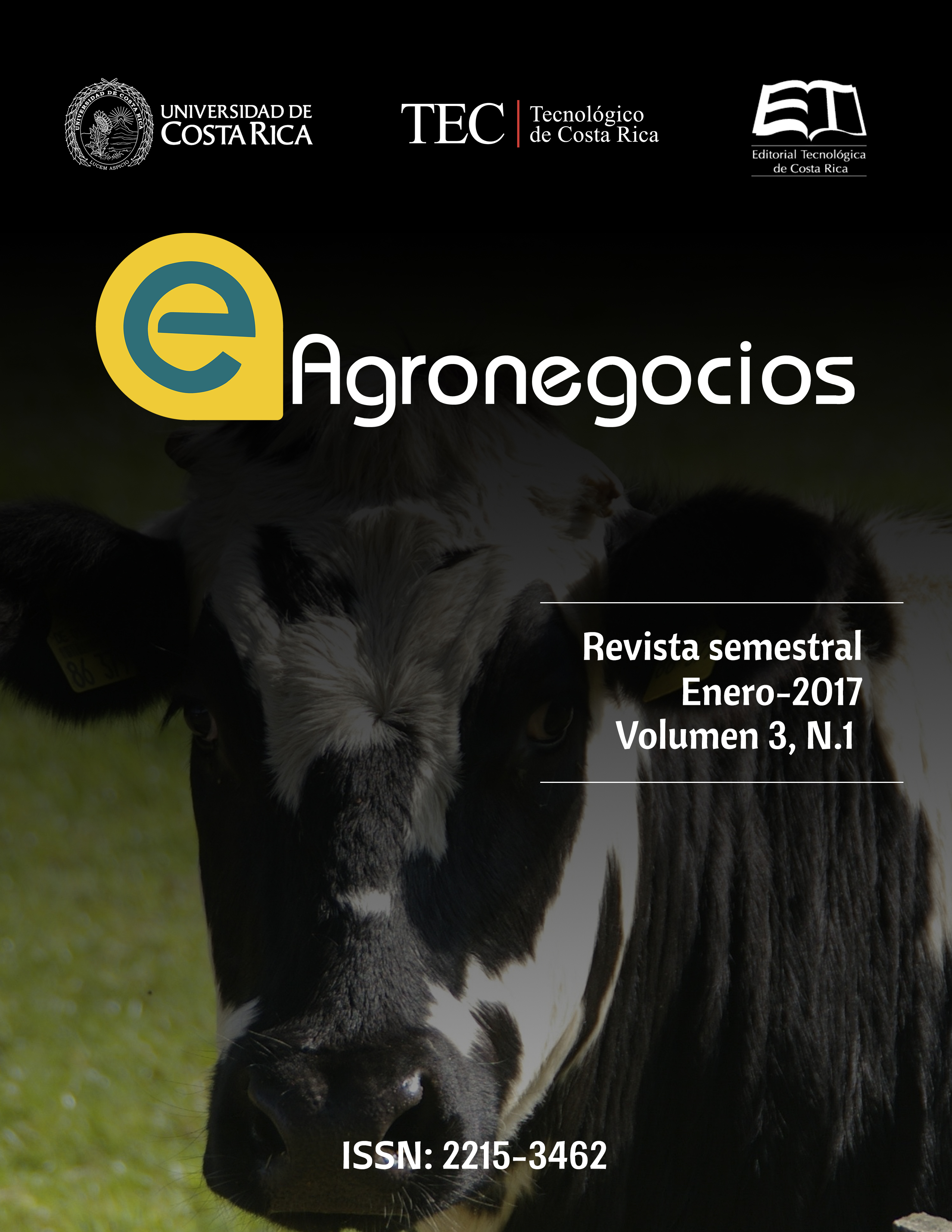Effect of distance to urban center on the value of rural land: the case of Guapiles
Main Article Content
Abstract
A research was carried out to determine the effect of the distance to the city of Guapiles on the value of the rural lands in the surroundings of this city. It was determined that the unit value per square meter declines exponentially as the distance, measured in kilometers, increases with a regression coefficient of -0.023.
The model showed that land size and distance to urban center accounted for 89% of the variability in the unit value of rural land.
The explosion of the accelerated development of the city of Guápiles has generated a pressure on the value of the land, as well as expectations, sometimes too high for the owners of the land.
Article Details

This work is licensed under a Creative Commons Attribution-NonCommercial 4.0 International License.
Las personas autoras conservan los derechos de autor/a y ceden a la revista el derecho de la primera publicación y que pueda editarlo, reproducirlo, distribuirlo, exhibirlo y comunicarlo en el país y en el extranjero mediante medios impresos y electrónicos. Asimismo, las personas autoras asumen el compromiso sobre cualquier litigio o reclamación relacionada con derechos de propiedad intelectual, exonerando de responsabilidad a la Editorial Tecnológica de Costa Rica. Además, se establece que los autores pueden realizar otros acuerdos contractuales independientes y adicionales para la distribución no exclusiva de la versión del artículo publicado en esta revista (p. ej., incluirlo en un repositorio institucional o publicarlo en un libro) siempre que indiquen claramente que el trabajo se publicó por primera vez en esta revista.
References
Alonso, R y Serrano, A. (1998). Valoración Agraria. Casos Prácticos de Valoración Agraria. Agrícola Española, Madrid.
Alonso, R. e Iruretagoyena, M. T. (1990). Casos prácticos de Valoración Agraria. Ministerio de
Agricultura Pesca y Alimentación, Madrid.
Arriaza, M.; Cañas Madueño, J.A. y Fernández Sánchez, J.I. (2002). “Valoración de fincas agrarias en la comarca de Pedroches (Córdoba)”. I Congreso Internacional de Valoración y Tasación. Valencia, 3-5 julio.
Bowerman, B.L. y O’Connell, R.T. (1990). Linear statistical models: an applied approach.
Duxbury.
Belmont, CA. Breusch, T. y Pagan, A. (1979). “A simple test for heteroscedasticity and random coefficient variation”. Econometrica, 47: 1287-1294.
Buitrago (2007). Factores determinantes del precio de la tierra rural en los municipios contiguos a Bogotá D.C. Cali, Colombia: Programa Editorial Universidad del Valle.
Caballer, V. (1993). Valoración agraria teoría y práctica. Mundi-Prensa, Madrid.
Caballer, V., (1999). Valoración de Árboles. Mundi Prensa, Madrid.
Calatrava Leyva, J. y Cañero León, R. (2000). Valoración de fincas olivareras de secano mediante métodos econométricos. Investig. Agra.: Producción y Protección Vegetal, 15 (1-2): 91-103.
Capozza, D. R. y Helsley, R. W. (1989). The fundamentals of land prices and urban growth. Journal of Urban Economics, 26 (3): 295-306.
Fraser, R. & Spencer, G. (1998) The value of an ocean view: an example of hedonic property amenity valuation. Australian Geographical Studies, 36(1), 94-98.
García Pérez, J., Cruz Rambaud, S. y Rosado López, Y. (2002). Extensión multi-índice del método beta en valoración agraria. Economía Agraria y Recursos Naturales, 2 (2): 3-26.
García Pérez, J.; Herrerías Pleguezuelo, R. y García García, L.B. (2003). Valoración agraria: contrastes estadísticos para índices y distribuciones en el método de las dos funciones de distribución. Revista Española de Estudios Agrosociales y Pesqueros, 199: 93-118.
Godfrey, L. (1978). Testing for multiplicative heteroscedasticity. Journal of Econometrics, 8: 227-236.
Greene, W.H. (1997). Econometric analysis. Prentice-Hall, New Jersey.
Gujarati, D.; & Porter, D. (2010). Econometría (5 Ed). México: McGraw-Hill Interamericana
Isackson, W. (1997). An empirical analysis of the determinants of the value of vacant land.
Journal of Real Estate Research 13 (2), 103-114.
McDonald, J. F. y McMillen, D.P. (1998). Land values, land use, and the first Chicago zoning ordinance. Journal of Real Estate Finance and Economics 16 (2): 135-150.
Mendelsohn, R., Nordhaus, W. D. y Shaw, D. (1994). The impact of global warming on agriculture: a Ricardian analysis. American Economic Review 84 (4): 753-771.
Palmquist, R. B. y Danielson, L. E. (1989). A hedonic study of the effects of erosion control and drainage on farmland values. American Journal of Agricultural Economics, 71 (1): 55-62.
Perry, G.M. y Robison, L.J. (2001). Evaluating the influence of personal relationships on land sale prices: a case study in Oregon. Land Economics, 77 (3): 385-398.
Plantinga, A.J. y Miller, D.J. (2001). Agricultural land values and the value of rights to future land development. Land Economics, 77 (1): 56-67.
Roka, F. M. y Palmquist, R. B. (1997). Examining the use of national databases in a hedonic analysis of regional farmland values. American Journal of Agricultural Economics, 79 (5): 1651-1656.
Sandrey R.A., Arthur L.M., Oliveira R.A. y Wilson W.R. (1982). Determinants of Oregon farmland values: A pooled cross-sectorial time series analysis. Western Journal of Agricultural Economics, 7 (2): 211-220.
Segura, B.; García Portillo R. y Vidal F. (1998). Modelos econométricos de valoración: aplicación de la valoración fiscal. Investigación Agraria: Producción y Protección Vegetal, 13 (1-2): 221-241.
Stewart, P.A. y Libby, L. (1998). Determinants of farmland values: The case of DeKalb
County,Illynois. Review of Agricultural Economics, 20 (1): 80-95.
White, H. (1980). A heteroscedasticity consistent covariance matrix estimator y a direct test ofheteroscedasticity. Econometrica, 48 (4): 817-818.
Wise, J.O. y Dover, H.J. (1974). An evaluation of a statistical method of appraising rural property. The Appraisal Journal, 42 (1): 103-113.

